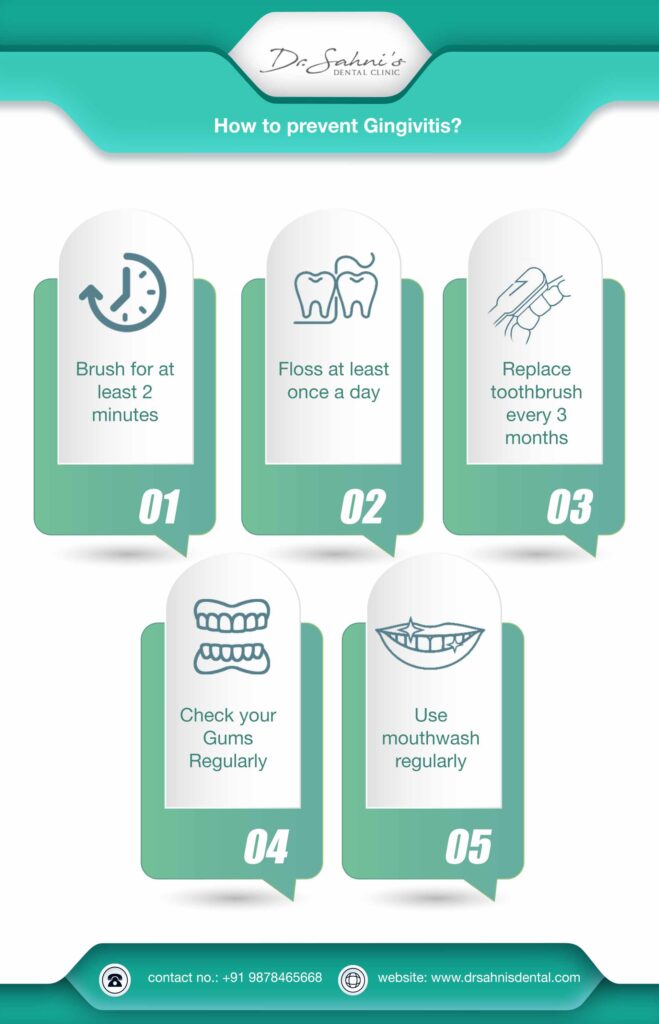It is a common myth that every dental problem starts with a root canal infection and ends with it too. If you have been experiencing sudden pain, discomfort, and swelling, it could be gingivitis too.
For those who aren’t aware, Gingivitis is a common form of gum disease that affects the gingiva of the oral cavity. If left untreated, Gingivitis can lead to a severe form of periodontitis and eventual tooth loss as well.
If you have been looking for more information about this dental condition, we have sorted out everything, from the signs and symptoms to the treatment options.
Table of Contents :-
Feel free to skip ahead if one topic catches your eye
- Types of Gingivitis
- Most Common Causes of Gingivitis
- Signs and Symptoms of Gingivitis
- Diagnosis of Gingivitis
- Possible Treatment Options
- Take Away
1. Types of Gingivitis :-
There are two primary types of Gingivitis that are medically known. They include:
Dental Plaque-Induced Gingivitis – This type of Gingivitis is caused by plaque, malnutrition, improper oral health, and the side effects of medications.
Non-Plaque Induced Gingivitis – The second type of Gingivitis is a more severe variant of the disease and is generally caused by a variety of microbes, including bacteria, viruses, or fungus. It can alternatively be caused by genetic predisposition, chronic illnesses or untreated wounds.
2. Most Common Causes of Gingivitis :-
There are not many specific causes of Gingivitis but dentists suggest that poor oral hygiene is the primary contributing factor behind the condition. The remnants of food inside the oral cavity often lead to an infection that causes your gums to inflame and cause pain or discomfort.
The accumulated plaque in between the teeth is the starting point of this gum disease. If you fail to maintain proper oral hygiene, this transparent film of plaque over the teeth leads to the infection of gingiva.
The plaque is generally formed as a thin transparent layer over the teeth when food particles react with the bacteria in the oral cavity. Improper removal of plaque leads to hardening of the deposition, causing accumulation of tartar. The tartar further becomes a breeding ground for the bacteria, causing infection in the oral cavity.
The prolonged presence of plaque and tartar in the oral cavity irritates the gingiva, leading to pain and inflammation. If left untreated, Gingivitis can even cause bleeding and eventual tooth decay.
Some Other Risk Factors Behind The Disease Are:-
- Terminal illnesses like cancer, diabetes, and HIV
- Side effects due to medications that reduce the salivary secretion
- Smoking
- Lack of healthy and balanced diet
- Age
- Genetic predisposition
- Hormonal changes during pregnancy
3. Signs And Symptoms of Gingivitis :-
The signs and symptoms of Gingivitis are pretty standard and you will likely confuse it for other dental disorders initially. Keep in mind that the condition of Gingivitis isn’t created overnight. Days and months of neglected oral hygiene are what eventually lead to gingivitis.
Some of The Common Symptoms Include:-
- Swelling around the gums along with persistent puffiness
- Bleeding gums
- Dark red gums
- Halitosis or Bad breath
- Tenderness around the gums
- Receding gums
Complications of Gingivitis :-
In addition to the primary symptoms, it is necessary one familiarizes themselves with the complications that the condition can cause. Some of prevalent ones include:
- Enhanced risks of recurring gum disease
- Loss of bone surrounding the tooth
- Loss of tooth/teeth
- Damage to the periodontal ligament
- Teeth mobility

4. Diagnosis of Gingivitis :-
The diagnosis of this dental disease generally starts when you are experiencing the signs and symptoms of Gingivitis. You need to book an appointment with an experienced dentist if the symptoms are persistent and don’t get better.
Once in the doctor’s office, they will start the diagnosis by conducting a thorough oral examination. The dentist will check for the presence of plaque and tartar and even probe into the gums to check for any kinds of inflammation or puffiness.
In case the infection has gotten a lot worse and has spread to the other parts of the mouth, your dentist will advise getting an X-ray done to check the status of the infection and possible signs of bone loss. If your dentist doesn’t specialize in treating Gingivitis, there are chances that they will refer you to a periodontist to get the required treatment.
5. Possible Treatment Options :-
The gum disease gingivitis treatment depends on the severity of the condition. Some gingivitis stages can be treated with a simple deep cleaning but the other severe types generally require antibiotics or even surgery.
Deep Cleaning – If you are struggling with plaque-induced gingivitis, deep cleaning is the easiest mode of treatment. The dentist uses techniques like scaling and root planing to remove the plaque or tartar from the teeth.
Antibiotics – If the gum infection has progressed and spread to the remaining parts of the oral cavity, the periodontist prescribes antibiotic medications or an antiseptic mouthwash to cure the infection and possibly drain it out of the gums. Oral antibiotics are prescribed if the gum inflammation doesn’t subside.
Surgery – This is the last cure for gingivitis and is often suggested as the last option when nothing else is working. Flap surgery is a common surgical procedure that is done to treat receding gums.
At Dr. Sahni, you are suggested with the best treatment options for Gingivitis with faster cure and recovery without any side effects or complications.
Take Away
While Gingivitis might not seem like a very serious disease in the preliminary stages, it can cause severe complications if left untreated. So, if you are experiencing any of the signs and symptoms of Gingivitis, it is better you consult a periodontist immediately for speedy diagnosis, treatment, and recovery.
